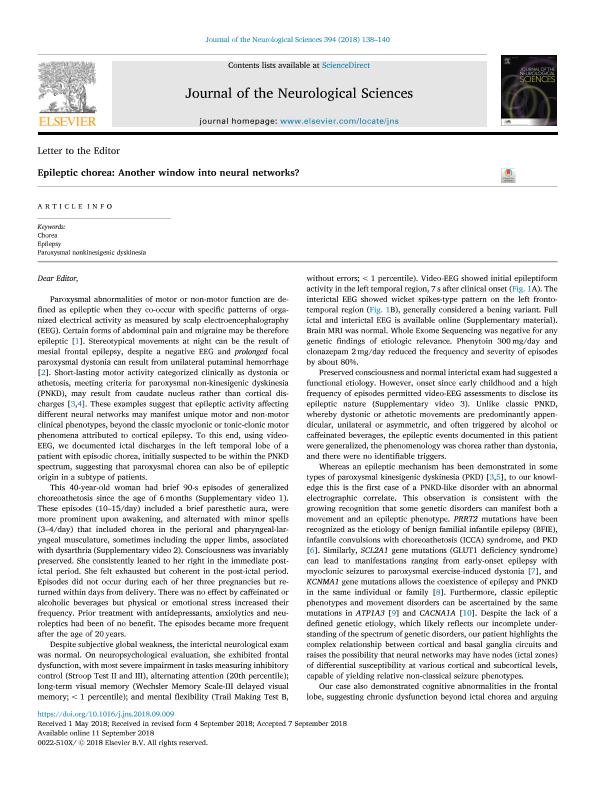Artículo
Epileptic chorea: Another window into neural networks?
Gameleira, Fernando Tenório; Alúcio, Karina Torres; de Paiva, Maria Luísa Maia Nobre; de Lima Carlos, Kathleen Caroline; de Lima, Kedma Mayara; Gameleira, Mariana Holanda; Kauffman, Marcelo Andres ; Espay, Alberto J.
; Espay, Alberto J.
 ; Espay, Alberto J.
; Espay, Alberto J.
Fecha de publicación:
11/2018
Editorial:
Elsevier Science
Revista:
Journal of the Neurological Sciences
ISSN:
0022-510X
Idioma:
Inglés
Tipo de recurso:
Artículo publicado
Clasificación temática:
Resumen
Paroxysmal abnormalities of motor or non-motor function are defined as epileptic when they co-occur with specific patterns of organized electrical activity as measured by scalp electroencephalography (EEG). Certain forms of abdominal pain and migraine may be therefore epileptic [1]. Stereotypical movements at night can be the result of mesial frontal epilepsy, despite a negative EEG and prolonged focal paroxysmal dystonia can result from unilateral putaminal hemorrhage [2]. Short-lasting motor activity categorized clinically as dystonia or athetosis, meeting criteria for paroxysmal non-kinesigenic dyskinesia (PNKD), may result from caudate nucleus rather than cortical discharges [3,4]. These examples suggest that epileptic activity affecting different neural networks may manifest unique motor and non-motor clinical phenotypes, beyond the classic myoclonic or tonic-clonic motor phenomena attributed to cortical epilepsy. To this end, using video-EEG, we documented ictal discharges in the left temporal lobe of a patient with episodic chorea, initially suspected to be within the PNKD spectrum, suggesting that paroxysmal chorea can also be of epileptic origin in a subtype of patients.
Palabras clave:
CHOREA
,
EPILEPSY
,
PAROXYSMAL NONKINESIGENIC DYSKINESIA
Archivos asociados
Licencia
Identificadores
Colecciones
Articulos(IIMT)
Articulos de INSTITUTO DE INVESTIGACIONES EN MEDICINA TRASLACIONAL
Articulos de INSTITUTO DE INVESTIGACIONES EN MEDICINA TRASLACIONAL
Citación
Gameleira, Fernando Tenório; Alúcio, Karina Torres; de Paiva, Maria Luísa Maia Nobre; de Lima Carlos, Kathleen Caroline; de Lima, Kedma Mayara; et al.; Epileptic chorea: Another window into neural networks?; Elsevier Science; Journal of the Neurological Sciences; 394; 11-2018; 138-140
Compartir
Altmétricas



